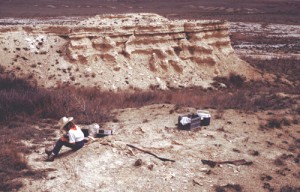What questions fall within the purview of “Paleontology”?
Quite a wide variety, it turns out, because paleontology is the study of prehistoric life – the exploration of the entire history of life. Since 99.9% of all species that existed are now extinct, that is a lot of biodiversity. The science is multifaceted and diverse because the topic is equally diverse.
Because of the connections with geologic time and rock formations as the context of fossils, most paleontology classes are offered through geology programs at universities. I LIKE teaching introductory courses in geology because I find that people frequently end up taking geology in college as a last resort. Students generally are required to take a science class with a laboratory and they too frequently review their options without much enthusiasm. They took biology in high school and did not like it then, so want to stay away from that now. Chemistry and physics sound like a lot of math, so that leaves geology, they reason.

Fossil collecting in western Kansas. A partial mosasaur skeleton is visible in the middle foreground.
On the first day of geology class I like to point out that the study of the Earth and its history involves biology, chemistry, and physics, so we will cover them all. There is usually a little moan from the class at this, and I enjoy my moment of sadism. Paleontology in particular incorporates biology and geology to a very high degree, because to study fossils you have to fully understand the animals as well as the history that you can read from the rock record.
So could we come up with a classification, not of fossils, but of paleontologists?
Since the topic is so multifaceted the science falls naturally into several key areas. For example, individual paleontologists tend to be more oriented toward either geology or biology. The first group might be more interested in the animals themselves: how did they live; how did they move and capture prey; how did they relate to other organisms in their environment.
The second group might be more interested in what the animals can tell them about the Earth’s history: what do the fossils tell us about the movement of plates over the Earth’s surface through time; when did different animals live in geologic time so we can estimate the age of rocks; that sort of thing.
Of course, this is an over simplification.
Paleontologists can also be classified by which group of organisms they work with. Is it plants (maybe fossil forests made of ferns), or invertebrates animals — marine or terrestrial – ranging from the largest squid ever known to fossil spiders, or maybe vertebrate animals.
A lot of the people I know are paleontologists, and they tend to be people with diverse interests, often ending up doing a bit of all of it. For example, many years ago I worked on a fossil locality in southwestern Kansas that included plant, invertebrate, and vertebrate fossils. Having all the groups of organisms was critical to interpreting a much fuller picture of the ancient environment there than any one of the groups alone could have provided.
As a paleontologists I must be a “jack of all trades,” and that is one of the things I love most about it.
Other interesting facts can be found here at Boneblogger. Enjoy.
